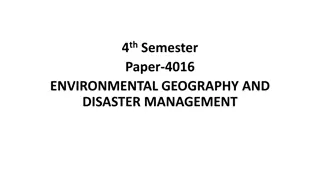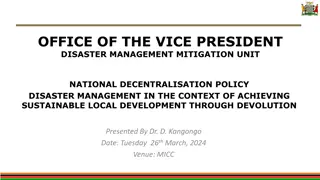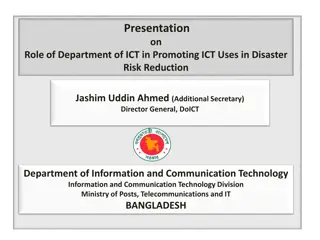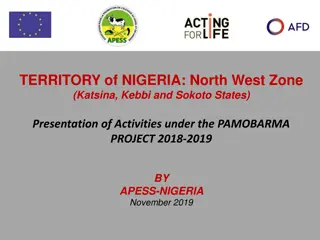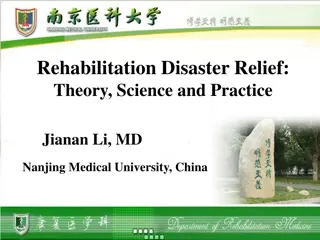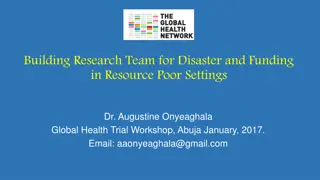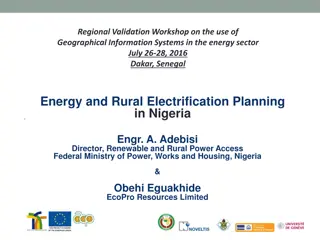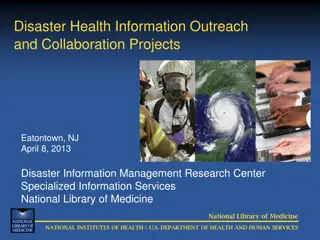Disaster Management and Evaluation in Nigeria
This presentation by the Director General of FCT Emergency Management Agency explores the overview of disaster situations in Nigeria, including causes, impact, and costs. It also delves into the management of disasters in Nigeria, addressing prevention, affected populations, and responsibilities. The importance of post-disaster monitoring and evaluation is emphasized throughout the presentation.
Download Presentation

Please find below an Image/Link to download the presentation.
The content on the website is provided AS IS for your information and personal use only. It may not be sold, licensed, or shared on other websites without obtaining consent from the author.If you encounter any issues during the download, it is possible that the publisher has removed the file from their server.
You are allowed to download the files provided on this website for personal or commercial use, subject to the condition that they are used lawfully. All files are the property of their respective owners.
The content on the website is provided AS IS for your information and personal use only. It may not be sold, licensed, or shared on other websites without obtaining consent from the author.
E N D
Presentation Transcript
A PRESENTATION BY THE DIRECTOR GENERAL FCT EMERGENCY MANAGEMENT AGENCY (FEMA) ALH. ABBAS G. IDRISS AT A CAPACITY BUILDING PROGRAMME FOR CLINICAL RESEARCH IN THE FACE OF DISASTER AND CONFLICT SITUATION IN MIDDLE AND LOW INCOME COUNTRIES ORGANIZED BY NATIONAL HOSPITAL ABUJA AND GLOBAL HEALTH TRIALS ON 28TH JANUARY 2017 ABUJA-NIGERIA 2
OUTLINE Overview of Disaster situations in Nigeria Overview of Post Disaster situations in Nigeria Disaster Management in Nigeria Monitoring of Post-Disaster Situation Evaluation of Post Disaster Situation 3
Overview of Disaster situations in Nigeria What is Disaster? What are Disaster Situations in Nigeria? Causes and Risk Factors for Disasters Impact and Costs 4
Disaster Management in Nigeria Can disasters be prevented in Nigeria? Who is affected in disaster and post disaster situations? Who is responsible for disaster management in Nigeria? Post Disaster Monitoring and Evaluation 5
What is Disaster ? Definition: Is a situation or event, which overwhelms local capacity, necessitating a request to national or international level for external assistance (definition EM-DAT or International considered in Emergency Disasters Data Base). 6
What is Disaster ? (cont.) Definition: Is a sudden, calamitous event that causes serious disruption of the functioning of a community or a society causing widespread human, material, economic and/or environmental losses which exceed the ability of the affected community or society to cope using its own level of resources. (Source: UN/ISDR 2004) 7
Database of the UN'S International Strategy for Disaster Reduction (UN/ISDR) At least one of the following criteria must be met before qualifying an incident as a disaster : a report of 10 or more people killed a report of 100 people affected a declaration of a state of emergency by the relevant government a request by the national government for international assistance. 8
What are the Disaster Situations in Nigeria? HUMAN-INDUCED DISASTERS Boko Haram Insurgency Herdsmen/Farmers conflicts Communal conflicts Ethno-religious violence Militancy Human trafficking(which often times results in large number of people trapped in the desert or high sea, and in need of emergency intervention- including medical aid). Building collapse Fire disasters 9
What are the Disaster Situations in Nigeria? (Cont.) HUMAN-INDUCED DISASTERS Transport disasters- road accidents, air disasters, boat mishaps, etc., Pipeline explosion Chemical poisoning (Lead poisoning in Zamfara) Political Unrest Petrol tanker explosion 10
What are the Disaster Situations in Nigeria? (Cont.) NATURAL DISASTERS: Flood-Ibadan, Onitsha and Lokoja, Benue, etc Land tremors- in Kwoi (Jaba Local Govt Area of Kaduna state). Health disasters-Ebola, Lassa fever, meningitis, Cholera, Avian virus(Bird flu) etc.; Mining disasters(largely as a result of the influence of man on the environment ) Landslides Gully erosion Wind storms Droughts 11
What are the Disaster Situations in Nigeria? (Cont.) NATURAL DISASTERS Ocean surge/beach encroachment Pest invasion/infestation(locust, quelea birds invasion, etc) 12
Post Disaster Consequences and Cost of Disasters Disasters in Nigeria have over the years impacted on the: People- Resulting in loss of lives, Internal displacement of people, with Public health consequences. Economy-Micro and macro-economy of Nigeria, i.e. loss of GDP, loss of businesses, capital flight and loss of stock, compromised governance systems and collaboration from external partners. Ecology-loss of ecological resources, destruction of vegetation and degradation of the natural and built environment. 1. 2. 3. 13
Post Disaster Consequences and Cost of Disasters (Cont.) Socio-economic consequences to the business communities, states and country running into billions of naira Loss of lives and destruction of farm lands across many states, including Jigawa, Adamawa, Kebbi, Zamfara, Katsina, Yobe, Gombe, Bauchi, Kano, Kaduna in 2015 and Cross River state in 2016. Shortage of food and safe drinking water. In Borno and Yobe, maternal mortality ratio are as high as 1500-2000 per 100 000 live births compared to the national average of 576 per 100 000 live births due to the impact of disaster (WHO 2015) 14
Post Disaster Consequences and Cost of Disasters (Cont.) Physical loss of limbs and body parts, lives, possessions and shelter Emotional trauma to victims, family members and the communities Psychological trauma to victims and family members (Post Traumatic Stress Disorders) and the communities Family dislocations and internal displacements Health challenges in IDP camps across Nigeria Malnutrition, with the under-five children worse affected Women and girl child sexual abuse in the IDP camps Affect national security and national development Hamper the attainment of Sustainable Development Goals by stressing up available resources and prevent smooth implementation of plans and programmes within a specified time frame. 15
Post Disaster Consequences and Cost of Disasters (Cont.) BOKO HARAM INSURGENCY According to WHO 2015 Report -From 2009-2015, Boko Haram insurgency has displaced 14.8 million people in Adamawa, Borno, Gombe and Yobe states. According to USAID fact sheets #2, fiscal year 2017 and dated October 28, 2016:- 2.6 million people are displaced by Boko Haram related insecurity in the Lake Chad Basin comprising Cameron, Chad, Niger and Nigeria. There are 2.1 million IDPs in Nigeria- according to IOM as at August 2016; 184,404 IDPs in Niger- as declared by Government of Republic of Niger (GoRN) in September 2016; 192,912 IDPs in Cameroon-by the UNHCR September 2016 Report and 89,010 IDPs in Chad- as declared by Office for Coordination of Humanitarian Affairs (OCHA) in October 2016; 1.8 million children are out of school as a result of this insurgency. 9.2 million people primarily in the North East require various forms of assistance. Severe Acute malnutrition has estimatedly gone up to about 14%. All these figures as captured by credible organizations and governments sum up the grave consequences of disaster. 16
Post Disaster Consequences and Cost of Disasters (Cont.) FLOOD DISASTERS In 2012 flood ravaged 30 out of 36 States in Nigeria displaced 2.1million people, killed over 363 people. Source: NEMA. In 2015, about 53 people died in 11 states from floods while more than 100,420 people were displaced. The affected states were Kano, Katsina, Sokoto, Kebbi, Zamfara, Kaduna, Jigawa, Adamawa, Yobe, Gombe and Bauchi. Thousands of houses, farmlands and property worth billions of Naira were also lost to the flood disaster in many local government areas affected in the northern states. In 2016, Hundreds of buildings were submerged and thousands displaced by flood in Plateau state with Rikkos and Gangare worse hit SEMA boss 17
Who is Saddled with the Responsibility of Monitoring and Evaluating Post-Disaster Situations in Nigeria? National Emergency Management Agency at the Federal, State and Local Government levels (NEMA, SEMA, LEMCs) Federal Ministry of Water Resources, Federal Ministry of Women Affairs(Women & children are always the worse hit), Federal Ministry of Health ( the most critical partner in preventing or minimizing loss of lives and paving the way for other interventions in the recovery process), Federal Ministry of Agriculture, Federal Ministry of Environment, Federal Ministry of Power, Works & Housing, etc; Disaster Management Directorates at the Federal and State Ministries of Health. Non-Governmental Organizations (NGOs), Civil Society Organizations (CBOs), National and International development partners, etc. Security and Law enforcement agencies Legal Practitioners and Judiciary 18
Post Disaster Recovery Post disaster recovery is a complex, multidimensional process. It is an attempt to bring a post disaster situation to a level of acceptability through the rectification of damage and disruption that have been inflicted upon the environment, people and institutions. It is also the process by which a disaster stricken area returns to normal. 19
Post Disaster Recovery (Cont.) Recovery includes the reconstruction of the physical environment ( roads, bridges and buildings) and the restoration of amenities (water and power) and social services (schools and health facilities). Local and Federal Government structures must also be restored. Restoration of security and sources of sustainable livelihoods. Supporting vulnerable groups, risk reduction, community participation and environmental protection. 20
POST-DISASTER RECOVERY NEEDS ASSESSMENT (Cont.) It is a frame work and approach to assessing post-disaster needs that has been applied in several countries globally (PDNA). It has two methodologies, 1. The Human Recovery Needs Assessment (HRNA). 2. The Damage, Loss and Needs Assessment (DaLA) Nigeria started using it since 2012 as a preferred assessment tool for the country 21
POST-DISASTER RECOVERY NEEDS ASSESSMENT (Cont.) Together the two streams (HRNA, DaLA) form a recovery Roadmap to achieve resilient recovery reconstruction of physical assets, restoration of service delivery, access to goods and services, governance and social processes, reduction of risks and building back a better environment. 22
MONITORING IN POST- DISASTER SITUATIONS 23
What is post disaster monitoring? The tracking of the post disaster recovery process using earmarked indicators to ensure successful completion. It also refers to the process of systematic and continual observation and recording of data on evolution and occurrences of hazards and disasters; or Management initiatives (planned or otherwise) with which the hazard, and disasters are handled; as well as- *Tracking activities and events occurring with the intention of improving disaster management in the future. This third definition is the context within which I will base my discussion of Monitoring and Evaluation- specifically on the health aspect of post-disaster in line with the objectives of this capacity building programme. 24
Why Post Disaster Monitoring? To ensure that healthrecovery objectives are being met- on time and within the stipulated budget. A means to track activities and results of post disaster health programmes. To provide accountability and assist on-going health recovery work on ground. To improve future aid policy. Without accountability and maximum impact on the use of funds, donors will be discouraged, hence the need for Monitoring & Evaluation. 25
OBJECTIVES OF POST DISASTER MONITORING To promote understanding of hazards on rescuers, health workers and disaster affected persons. To facilitate informed forecasts and preparedness, as disasters have the tendencies for recurrence. 26
OBJECTIVES OF POST DISASTER MONITORING (Cont.) To promote disaster awareness, especially on the challenges of implementing health recovery programs. To coordinate participatory partnership among stakeholders. For comprehensive resource mobilization. 27
OBJECTIVES OF POST DISASTER MONITORING (Cont.) To obtain reliable data upon which present and future courses of actions will be based. 28
Operations That Need Monitoring in Post Disaster Health Recovery Health Recovery is the most critical among all the aspects of Post Disaster Recovery. Key operations that should be monitored include(but not limited to) the following: The entire rescue operation( rescue equipment used, emergency medical system in place , quality of medical services given to victims up to the point of discharge- including treatment for problems). All these should be monitored to ensure that they meet minimum standards in terms of best practices. Post-traumatic psychological 29
Operations That Need Monitoring in Post Disaster Health Recovery (Cont.) Resource mobilization(from government and donors) and utilization- this is critical to the success of health recovery programmes, hence the need for proper monitoring to ensure accountability and efficient utilization. Capacity building programmes for all categories of health workers(Surgeons, Pediatricians, Health workers, Epidemiologist, Nutritionists, Reproductive Health workers, Pharmacists, Psychiatrists, etc) should be closely monitored to ensure that they provide the right knowledge, skills and attitude necessary for handling all sorts of emergency health challenges both in the short and long run. Environmental/Sanitary 30
Operations That Need Monitoring in Post Disaster Health Recovery (Cont.) Level of knowledge and compliance to international/regional conventions, agreements and treaties(such as United Nations and Kampala Conventions in dealing with disaster affected persons). As persons who have lost their livelihoods and also in need of medical care, they are, by international humanitarian laws, entitled to medical and other forms of assistance and protection, hence compliance to this laws must be closely monitored. 31
Evaluation While Monitoring aims to keep track of activities and progress of post-disaster programs and collection of relevant data Evaluation is concerned effectiveness, efficiency and impact of post disaster activities in the light of specific objectives and resource allocation. In successful implementation of health recovery programs, there should be a balance between expected and actual outcomes, in terms of quality, quantity and timeliness in delivery. with the relevance, 33
Indicators for Evaluation of Outcomes Outcomes Standard Emergency Health Service Delivery Indicators for evaluation Quality of rescue equipment, systems and services available. High or Low? Amount of funds allocated and number of damaged health facilities reconstructed or rehabilitated in disaster affected communities within a given period. High or Low? Quality of capacity building programmes administered to Emergency health workers and level of skills and knowledge obtained. High or Low? Number of disaster affected persons successfully treated. High or Low? Healthcare provider s level of knowledge and compliance to international humanitarian laws on the right to assistance and protection of disaster affected persons. High or Low? 34
Challenges of Post-Disaster Monitoring and Evaluation Monitoring and Evaluation is a challenge in post-disaster settings because: Data is especially hard to obtain and analyze due to bureaucratic bottlenecks. Disaster affected persons and communities often feel that research on the impact of the disaster is an unwelcome intrusion on a painful experience and would rather not talk about it. High presence of security Agents- insurgents or militants in affected areas makes it difficult to undertake proper monitoring and evaluation on grounds of safety. Baseline data to be used for comparison in the evaluation process are not always available or accurate where available. This makes objective evaluation difficult. 35
Recommendations on Post-Disaster Monitoring & Evaluation There is the need for strict enforcement of the Freedom of Information Law to remove bureaucratic bottlenecks and enable free flow of information to aid Post disaster planning, implementation, monitoring and evaluation. Survey and baseline data collection from affected persons and communities should be undertaken by Community Based Organizations for reasons of their close affiliation with the communities and mutual trust. There should be greater understanding and collaboration between Monitoring and evaluation officers and Security Agencies by balancing the provision of safety and need for data collection and evaluation for planning purposes in Post Disaster Health Recovery. This can be achieved through stakeholders meetings. 36
References WHO 2015 Report on Insurgency in the North East from 2009-2015 WHO 2016 Report on Conflict in North East Nigeria Update 2 September 2016 USAID fact sheets of #2, fiscal year 2017 and dated October 28 Okoli AC. Disaster management and National Security in Nigeria: The Nexus and the Disconnect. Int. J Liberal Arts and Social Science. 2014; 2(1):1-39 National Disaster Recovery Strategy and Framework (NDRSF) 2015 National Emergency Management Agency Newsletter. Aug 2016; 8(8):3-5 Monitoring and Evaluation of Disaster Recovery & Risk Reduction. www.gfdrr.org/sites/gfdrr.org/files/3-Monitoring_and_Evaluation.pdf assessed online on 30/11/16 1. 2. 3. 4. 5. 6. 7. 37




